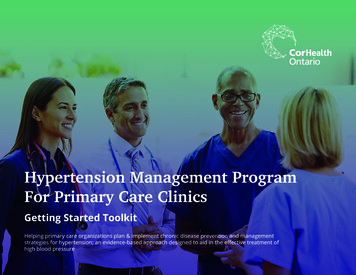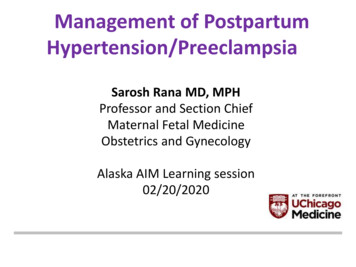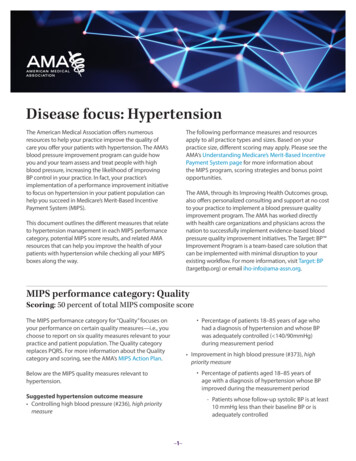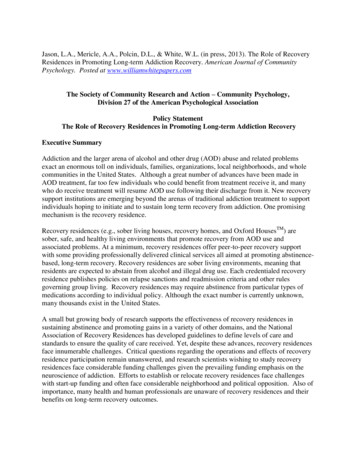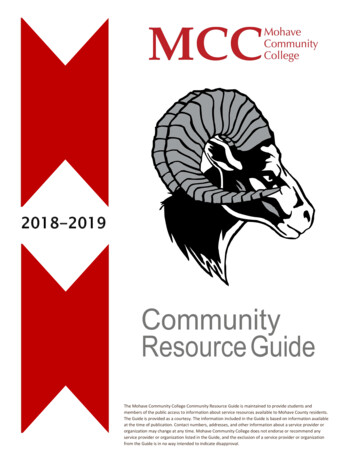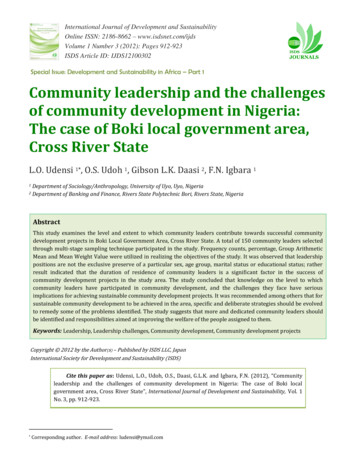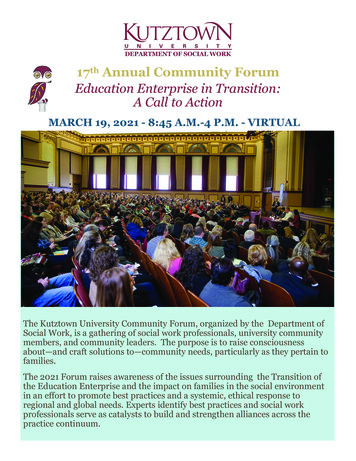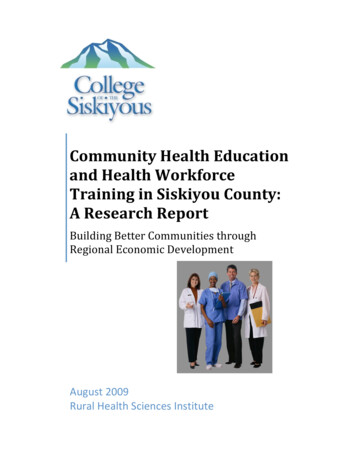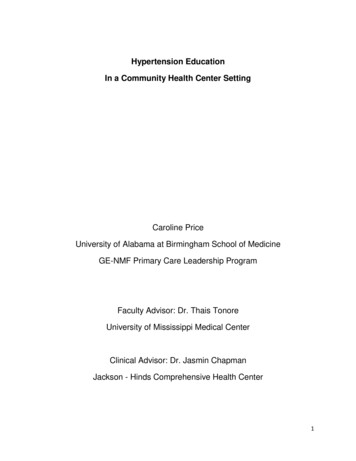
Transcription
Hypertension EducationIn a Community Health Center SettingCaroline PriceUniversity of Alabama at Birmingham School of MedicineGE-NMF Primary Care Leadership ProgramFaculty Advisor: Dr. Thais TonoreUniversity of Mississippi Medical CenterClinical Advisor: Dr. Jasmin ChapmanJackson - Hinds Comprehensive Health Center1
IntroductionAccording to the Centers for Disease Control and Prevention High BloodPressure Fact Sheet, hypertension is defined as a blood pressure of higher than140mmHg systolic pressure and 80mmHg diastolic pressure. Prehypertension isconsidered 120-139mmHg systolic pressure and 80-89mmHg diastolic pressure.A normal blood pressure is considered to be less than 120 mmHg systolic over80mmHg diastolic pressure.Understanding the ProblemUnfortunately, the CDC High Blood Pressure Fact Sheet reports that almost athird (31.3%) of American adults has Hypertension. It must also be noted that 1in 4 American adults also have prehypertension. These proportions are projectedto increase. “Normal” blood pressure is becoming exceptional.Understanding the LocationI was placed in Jackson, Mississippi at the Jackson-Hinds ComprehensiveHealth Center. Jackson is the state capital of Mississippi, and is located in HindsCounty slightly to the south and west of the center of the state of Mississippi. TheJackson-Hinds Comprehensive Health Center has many satellite clinics includingclinics in the Mississippi cities of Utica, also in Hinds County, Hazlehurst inCopiah County, Vicksburg in Warren County, and the Homeless Clinic, SouthClinic, and Medical Mall Clinic in Jackson.The main Jackson-Hinds Comprehensive Health Clinic is the Dr. JamesAnderson Health facility. It is located in Jackson at 3502 West Northside Drive,conveniently right off of I-220 at the intersection of Medgar Evers Boulevard andNorthside Drive, two of Jackson’s biggest streets.The Jackson Medical Mall is at 350 West Woodrow Wilson Drive in Jacksonbetween I-220 and I-55. It is literally an old mall that has been filled withbusinesses that predominately offer health and human services. The Universityof Mississippi Medical Center has many primary and specialty care clinics. Inpartnership with the University of Mississippi Medical Center, Jackson-HindsComprehensive Health Center physicians staff a Health Clinic at the MedicalMall. Through this partnership, University of Mississippi Medical Center residentshave an opportunity to learn in a Community Health Center environment. ThisPartnership is one of a few of this type. This residency model is currently beingobserved by many academic institutions in this country.2
The Homeless Clinic is located at 327 Gallatin Street in Jackson, and serves anyperson seeking services. A large portion of its patients however are homeless, orare newly released prisoners.The South Jackson Clinic is located at 145 Raymond Road in Jackson.The Utica Clinic, Vicksburg Clinic, and Hazlehurst clinics are all a 40-50 minutedrive from the Jackson-Hinds main site.Utica is located in Hinds County southwest of Jackson.Vicksburg is directly to the west of Jackson, almost in Louisiana. The Vicksburgclinic is located at 1203 Mission Park Drive.Hazlehurst is south and slightly west of Jackson in Copiah County.There is also a clinic in Tougaloo, but the Jackson-Hinds Comprehensive HealthCenter only provides dental services there.Understanding Clinic PopulationAccording to GE-NMF Primary Care Leadership Program Orientation PacketSection IIIa, the population of Mississippi is less healthy than the nationalaverage. This is especially true when referring to factors contributing tohypertension. The Demographic and Health Data sheet shows a rate ofpremature death that is approximately twice the national average. Roughly 22%of Mississippians are considered in poor or fair health compared with only 10% ofthe general United States population. Hinds County is slightly better than the restof Mississippi with only 20% considered in poor or fair health, but still significantlybehind the national average. Mississippians are reported to have more poorphysical health days than the national average, as well as more poor mentalhealth days. Low birthweight is also more common in Mississippians. Adultsmoking in Mississippi is 24%, compared to the national average of 14%. SectionIIIa cites Mississippi adult obesity as 36%, compared a national average of 25%.Physical inactivity is reported as 33% in Mississippi, compared to the national21%. Excessive drinking is even more common in Mississippi than nationally. Allof these factors are risk factors for hypertension.Orientation Packet Section IIIa reports that in Mississippi, there is on average 1primary care physician per 1,155 patients, with the national average being 1primary care physician per 631 patients. Hinds County, where the main JacksonHinds site is located, is much better than the Mississippi average with 1 primarycare physician per 711 patients. Even though it is better than the rest of the stateof Mississippi, Hinds County is still worse than the national average. This3
physician to patient ratio is important. Educating patients about hypertension andspeaking with patients in depth about lifestyle takes time. According to SectionIIIa, there is considered to be no limited access to healthy foods nationally, but inMississippi there is limited access for 11% of people and in Hinds County, 18%.Fast food restaurants are used by 25% of the nation, but by 55% of people inMississippi and 62% of people in Hinds County. According to the American HeartAssociation, it is known that African Americans are at risk for hypertension due tosalt sensitivity, and possibly also due to increased rates of diabetes and obesity.Section IIIa cites African Americans as making up 37% of the Mississippipopulation versus only 12% of the nation. When this is considered, along with thepreviously mentioned risk factors which are prevalent in Mississippi, it is notsurprising that physicians in Mississippi see a disproportionately high number ofhypertension patients.Developing the InterventionProject development began with interest in a topic related to obesity or itssequelae. While the obesity epidemic is a problem that needs to be targeted, it ismore socially acceptable to target obesity from a hypertension standpoint thandirectly.I met with and or shadowed many clinicians including Dr. Jackson in FamilyMedicine, Dr. McNair, Dr. Hutchins, Dr. Rice, and Ms. Watson in Adult Medicine,Dr. Watson, Ms. Burr, and Dr. Assad in Pediatrics, Dr. Attipoe, Ms. Gordon, andMs. Mayeaux in Women’s Health. I also got to shadow nutritionist, Ms. TammyHawes, social worker Ms. Martha Magnuson, and Mrs. Mason, a Jackson-HindsComprehensive Health Center employee who is involved in a Morehouse CollegeHypertension study. All clinicians and staff members that I spoke with gave medifferent perspectives on the issue of hypertension.Dr. Jackson, Family Practitioner at the Utica Jackson-Hinds ComprehensiveHealth Center site emphasized the importance of one-on-one patient educationand allowed students shadowing to utilize a survey created by Dr. Rice, JacksonHinds Comprehensive Health Center Director of Internal Medicine, to gaugepatient understanding and health maintenance. The survey was administeredwhile patients waited in exam rooms for the physician. The survey was then usedas a platform to target areas in which patients need education. The surveyengaged patients and seemed to make them feel involved in their medical care,in addition to keeping them occupied while they were waiting on Dr. Jackson toenter the room. Both the patient perception of a shorter wait time, and a back andforth conversation with the physician or student about health concerns seemed toincrease patient satisfaction.4
Dr. Herman Taylor of the Jackson Heart Study referred me to Dr. Deborah Minor,also of the Jackson Heart Study. Dr. Minor, with Dr. Richard deShazo and Mr.Michael Jones, have a program that enables volunteers to be health advocates.Dr. Minor, Dr. deShazo, and Mr. Jones are involved with both Train the HealthAdvocate Programs and Train the Trainer programs. I was able to attend a Trainthe Trainer Session and get certified. Highlights of the program training includedlearning the efficacy of teaching a patient to read a BMI chart, and how to givebasic dietary advice. Participants also learned how to take blood pressures andblood glucose readings. Participants of the program ranged from nurses topastors to concerned community members.The InterventionA survey concerning hypertension was chosen to function, like Dr. Rice’s survey,as a patient education tool. Results could also be collected to see if there is apopulation of patients that is being missed by health education efforts. Thesurvey is included in Appendix A for reference.In addition to the survey, handouts were employed to give to patients so that theycould better remember educator discussion and share health education with theirfamilies and friends.Several handouts were collected. Mr. Thomas Payne of the ACT Center, aUniversity of Mississippi Medical Center Tobacco Cessation Clinic at the JacksonMedical Mall, gave handouts both for the ACT Center and for the 1-800-QUITNOW Mississippi Tobacco Quitline. These brochures are shown in Appendix Band C respectively. Both of these interventions are free to participants. While theMississippi Tobacco Quitline works primarily via telephone, the ACT Centerrequires participants to come to the Jackson Medical Mall. In addition, aHypertension Overview handout provided by WIC Nutritionist Ms. Tammy Haweswas used. The Hypertension Overview handout is shown in Appendix D.Several handouts were made. The first, shown in Appendix E, is a sheet ofsimple diet and exercise tips. The second, shown in Appendix F, is simply acolorful and easy to read BMI chart that was found online. The third, shown inAppendix G, is a sheet of active games for children to play outdoors.Mrs. Mason, a Jackson-Hinds Comprehensive Health Center employee who is incharge of the Jackson branch of a Morehouse College Hypertension Study,reviewed both survey and handouts.5
The survey was approved by Dr. Rice, Director of Internal Medicine at JacksonHinds Comprehensive Health Center. Handouts were approved by Ms. Singleton,Nursing Director at Jackson-Hinds Comprehensive Health Center.ComponentsEdwards, MississippiEdwards, Mississippi will be the site of a new Jackson-Hinds satellite clinic. July10th, a hypertension education session was given at the Edwards NeighborhoodCenter in conjunction with GE-NMF Primary Care Leadership Program scholarHal Flowers’ project “An Assessment of Community Health Needs in Edwards,Mississippi.” All participants received a copy of each handout. No surveys wereadministered.Survey DistributionFellow GE-NMF Primary Care Leadership Program scholars Hal Flowers andCarolita Heritage collected the surveys that were distributed at the HomelessClinic and South Jackson Clinic.Vicksburg and Hazlehurst clinic surveys were dropped off and later collected bythe author. An informal waiting room education session with the assistance ofhandouts was performed in Hazlehurst.Utica clinic surveys were administered while shadowing and patient educationwas performed by the author. Handouts were distributed as needed. When morethan basic education was needed, it was provided by Dr. Jackson.ResultsThere were 47 surveys. Surveys were only administered to adults. Age rangespolled were 29 and younger, 30-39, 40-49, 50-59, and 60 and older. There wereat least 7 surveys per age group with 7 participants 29 and younger, 8participants 30-39, 8 participants 40-49, 14 participants 50-59, and 10participants 60 and older.Because of the small sample size, surveys from multiple sites were compiled.Results are shown in Tables 1-5.In addition to the survey results, there were immediate positive results to theproject. Because of the “Does lack of money ever prevent you from getting your6
medications?” question, one hypertensive woman who had not previously beenidentified as needing to see the social worker was sent to the social worker.Most participants who received education identified an area that they wanted toimprove in, such as decreasing sodium in diet, or losing weight.Table 1Table 27
Table 3Table 4Table 58
EvaluationThe 30-39 year old age range was the least likely to get the high blood pressurerisk factor question correct, with only 37.5%, compared to the next lowest groups,29 and younger and 50-59, which were tied with 51.7%.The 30-39 year old age range was also the least likely to know that there is quitea bit of sodium in sodas at 37.5%. The next lowest group was the 40-49 year oldage range with 50%. 100% of 29 and younger participants knew that sodas are asource of sodium.The 30-39 year old age range was the most likely to drink regular sodas at87.5%. The next lowest groups were the 29 and younger and the 50-59 groups,which were tied with 51.7%.100% of 30-39 year old participants wanted further education. The next highestgroup was the 40-49 year olds with 87.5%, closely followed by the 50-59 yearolds with 85.7%.ConclusionAlthough the 30-39 year old age range appeared to be the least educatedaccording to the survey, they were the most receptive to hypertension education.Because these 30-39 year old patients should have long lives ahead of them, it isimperative that education efforts be focused on this age group.AcknowledgementsThank you GE and National Medical Fellowship for providing such an excellent summeropportunity.Thank you Faculty Advisor, Dr. Thais Tonore of the University of Mississippi MedicalCenter, Clinical Advisor, Dr. Jasmin Chapman, CEO of Jackson-Hinds ComprehensiveHealth Center. In addition, thank you Dr. Lynda Assad, Jackson-Hinds ComprehensiveHealth Center Medical Director and Director of Pediatrics, and Dr. Nedra Jackson,Family Practitioner at the Utica clinic, for providing valuable assistance andencouragement.Through Jackson-Hinds Comprehensive Community Health Center, I was able to learnleadership skills by speaking with community health leaders including:Dr. John Patterson, Clinical Director, Jackson-Hinds Comprehensive HealthCenterMr. Jeffrey Aldridge, CFO Jackson-Hinds Comprehensive Health Center9
Mr. Robert Pugh, Mississippi Primary Healthcare AssociationMr. Frank Crump Jr., Board Chair, Jackson-Hinds Comprehensive HealthCenterMs. Sandra Gray, Safety Officer Jackson-Hinds Comprehensive Health CenterMs. Beneta Burt of Mississippi Roadmap to Health EquityMr. Michael Jones of Healthy Linkages and Train the TrainerDr. Richard deShazo of Southern Remedy and Train the TrainerDr. Deborah Minor of the Jackson Heart Study and Train the TrainerDr. Herman Taylor of the Jackson Heart StudyMr. Justin Smith, Compliance Officer, Jackson-Hinds Comprehensive HealthCenterMs. Amber Clark, Jackson Heart Study Scholar, M2 at Brown University Schoolof MedicineMs. Bass, Diabetes Educator, Jackson-Hinds Comprehensive Health CenterMs. Mason, Coordinator, Jackson Portion of Morehouse Hypertension GrantIn addition, I attended:2 Board MeetingsManagerial MeetingQuest Lab Group MeetingRegion 4 Infertility Prevention Project meetingState Department of Health meetingConcordant Healthcare Solutions meetingDelta Health Alliance meetingJackson, Mississippi Mayor Harvey Johnson Jr.’s State of the City AddressThank you to all of the clinicians and employees of Jackson-Hinds ComprehensiveHealth Center who took the time to speak with me and impart wisdom, with specialthanks to Ms. Wanesley and Ms. Bradley for their daily assistance.I feel that all of my experiences in Jackson were exceptional. Each experience andinteraction helped me shape my project, as well as my interactions with patients.Thank you fellow GE-NMF Primary Care Leadership Program Scholars Hal Flowers,Carolita Heritage, and Kristy Alvarez for providing support and encouragement.10
Works CitedACT Center, The University of Mississippi Medical Center. ACT Center for TobaccoTreatment, Education and Research. Flyer used to publicize University of MississippiMedical Center’s ACT Center.American Heart Association (2011). High Blood Pressure and African Americans.Retrieved from ssure/High-Blood-Pressure-and-AfricanAmericans UCM 301832 Article.jspCenters for Disease Control and Prevention, Division for Heart Disease and StrokePrevention. (2012). Retrieved from website:http://www.cdc.gov/dhdsp/data statistics/fact sheets/fs bloodpressure.htmGE-NMF Primary Care Leadership Program. Orientation Packet Section IIIaDemographic and Health Data by City. File that was given to GE-NMF Primary CareLeadership Program scholars at Site Orientation.Mississippi State Department of Public Health. 1-800-QUIT-NOW. Flyer used topublicize Mississippi’s 1-800-QUIT-NOW Tobacco Quitline.WIC Department, Jackson-Hinds Comprehensive Health Center (2008). Hypertensionalso known as High Blood Pressure. Flyer used by Jackson-Hinds ComprehensiveHealth Center WIC Nutritionists.11
Appendix A12
Appendix B13
Appendix C14
Appendix D15
Appendix E16
Appendix F17
Appendix G18
Nursing Director at Jackson-Hinds Comprehensive Health Center. Components Edwards, Mississippi Edwards, Mississippi will be the site of a new Jackson-Hinds satellite clinic. July 10th, a hypertension education session was given at the Edwards Neighborhood Center in conjunction with GE-NMF Primary Care Leadership Program scholar
